A beautiful sunset dotted with peafowls PC: Kalirajan Subramanian
Mid August 2022. We were visiting the National Capital Region(NCR) on personal work. Our last visit was more than 12 yrs ago when we had been to the most touristy places like Agra, Kullu, Manali etc. Our interest in wildlife was just beginning to sprout back then and with much younger kids the interests were also quite different. So this time, when we had 2 comparatively relaxed days in hand, we decided to visit the most iconic birding spot just few hours on road(along the Delhi-Agra expressway, just about 2 hours from Mathura) from NCR - The Bharatpur Birds Sanctuary, Rajasthan.
Officially known as the Keoladeo National Park or the Keoladeo Ghana National Park, the bird sanctuary is a man-made wetland which was earlier a hunting ground for the Maharajas of Bharatpur and later the British Viceroys. This wetland protects Bharatpur from floods and also acts as pastural ground for cattle. It was declared a bird sanctuary in 1976, a Ramsar site in 1981 and a national park in 1982. Locally known as Ghana, this sprawling 29 sqkm reserve is a combination of diverse dry grasslands, woodlands, woodland swamps and wetlands thereby home to 366 bird species, 379 plant species, 50 species of fish, 13 snake species , 5 species of lizards, 7 amphibian species, 7 turtle species and a host of other invertebrates.
Every year during the migration season between Oct-Mar thousands of birds make this sanctuary their breeding haven. During this time, it is home to rare migratory ducks and birds like Siberian cranes, Sarus cranes. Though we visited during the non-migratory season there were ample variety of birds to be seen, some still nesting. The park has rickshaws lined up to take the visitors on birding trips. There are naturalists who can guide the visitors on extra-charge. Some of the rickshaw drivers here are actually birding experts too. From our personal experience we highly recommend going on a rickshaw ride with Mr. Kaptan Singh 8290275675. He is quite knowledgeable about birds and actually interested in bird watching and conservation.
Bee eaters:
 |
| Little Green Bee Eaters(Merops orientalis) PC: Kalirajan Subramanian |
There are three type of Bee eaters known to be recorded in the sanctuary. The little green bee eater, blue cheeked bee eater, blue tailed bee eater. These are all slender, vibrantly coloured birds with pointed tail wing. As the name suggests, their beaks are designed to catch their main prey the bees and insects. Once caught, the bee eaters are known for the power-packed smashes they deliver on their prey by beating them against their perch before eating them. The little green bee eater shown above is also known as the Asian green bee eater.
 |
| Blue cheeked bee eater (Merops persicus) PC: Kalirajan Subramanian |
The blue cheeked bee eater has blue sides on its face(therefore the name) with a black eye stripe, and a yellow and brown throat where as the little green bee eater is predominantly green through out with a golden patch on the crown and upper back and a greenish blue throat. The little green bee eater is a resident bird while the other two are passage migrants.
There are 5 types of doves seen here. Oriental Turtle-Dove (Streptopelia orientalis), Laughing Dove (Streptopelia senegalensis), Spotted Dove (Streptopelia chinensis), Red-collared Dove (Streptopelia tranquebarica), Eurasian Collared Dove (Streptopelia decaocto).
 |
| Laughing dove(Streptopelia senegalensis) PC: Kalirajan Subramanian |
 |
Laughing dove(Streptopelia senegalensis) PC: Kalirajan Subramanian
|
 |
Pair of Laughing doves(Streptopelia senegalensis) PC: Kalirajan Subramanian
|
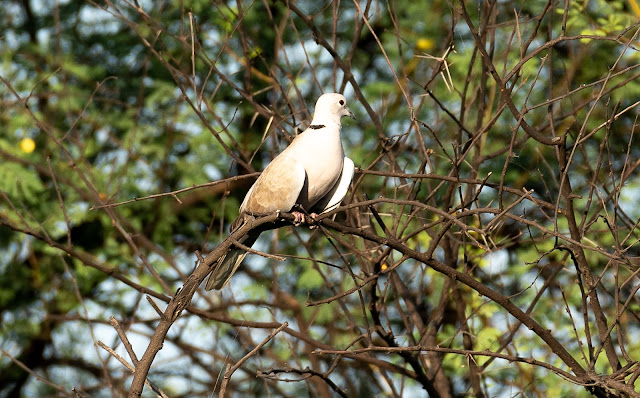 |
| Eurasian Collared Dove (Streptopelia decaocto) PC: Kalirajan Subramanian |
 |
| Red collared dove (Streptopelia tranquebarica) PC: Kalirajan Subramanian |
Small and Medium Sized Birds:
There were numerous starlings, mynahs, larks, munias, barbets and stonechats. Here are a bunch of varied birds that we spotted on different types of perches in the park
 |
| Ashy crowned sparrow lark female PC: Kalirajan Subramanian |
 |
| Coppersmith Barbet relishing a fresh fig PC: Kalirajan Subramanian |
 |
| Coppersmith barbet PC: Kalirajan Subramanian |
 |
| Indian Silverbills PC: Kalirajan Subramanian |
 |
| Indian Silverbill PC: Kalirajan Subramanian |
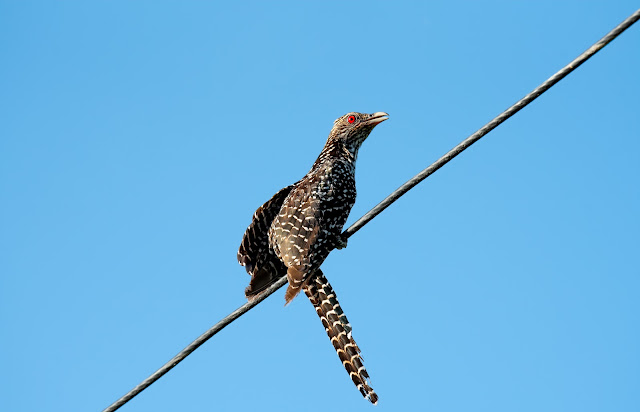 |
| Asian Koel Female with bright red eyes PC: Kalirajan Subramanian |
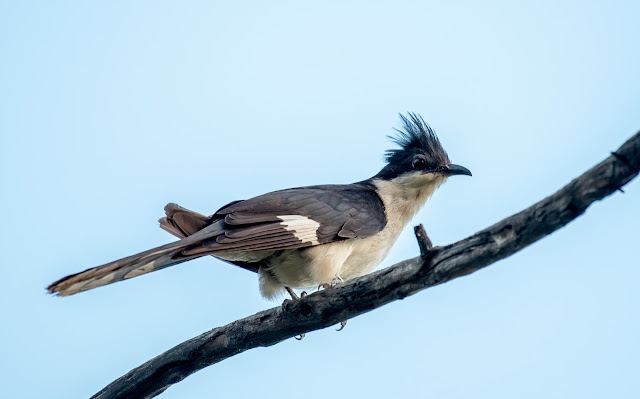 |
| Pied Cuckoo (called the harbinger of rains. The arrival of this bird is set to indicate the start of monsoon in the north ) PC: Kalirajan Subramanian |
 |
| Pied Cuckoo @ Jacobin Cuckoo PC: Kalirajan Subramanian |
 |
| Red headed bunting Female PC: Kalirajan Subramanian |
 |
| The ubiquitous Indian Roller PC: Kalirajan Subramanian |
 |
| Back pose of a Rufous Treepie(the classic mix of golden, grey, black and white) PC: Kalirajan Subramanian |
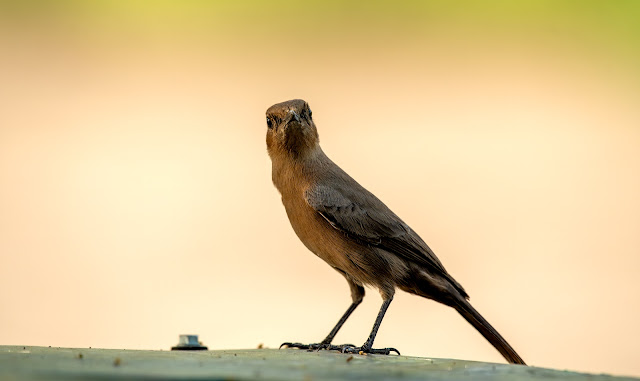 |
| Brown rockchat(Its eyes and neck make it seem always curious) PC: Kalirajan Subramanian |
 |
| Brown Rockchat PC: Kalirajan Subramanian |
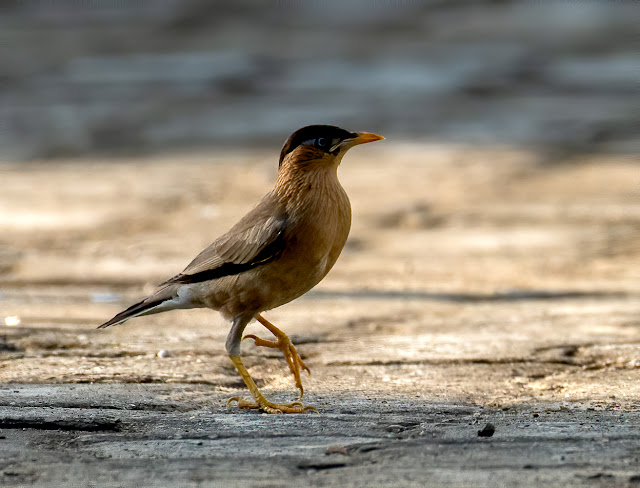 |
| Brahminy Starling PC: Kalirajan Subramanian |
 |
| A Brahminy Starling steps into a puddle of water on a parched Rajasthan evening PC: Kalirajan Subramanian |
 |
| The same Brahminy Starling gleefully takes a splash PC: Kalirajan Subramanian |
 |
| White eared bulbul PC: Kalirajan Subramanian |
 |
| White eared bulbul(notice the yellow vent underneath) PC: Kalirajan Subramanian |
 |
| Purple sunbird females PC: Kalirajan Subramanian |
 |
| Girls bonding (Purple sunbird females) PC: Kalirajan Subramanian |
Owls and Night jars
Of the 4 types of night jars and around 10 types of Owls seen in the park, we spotted the Large tailed nightjar (Caprimulgus macrurus) and the Spotted owlet (Athene brama)
 |
| Large tailed nightjar resting PC: Kalirajan Subramanian |
 |
| Large tailed nightjar alert and aware of our presence yet still PC: Kalirajan Subramanian |
 |
A sleepy-drowsy Spotted Owlet PC: Kalirajan subramanian
|
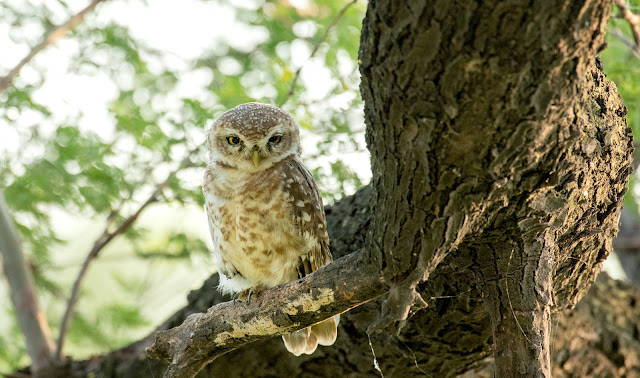 |
| That 'Why do you have to break my sleep' look we were given from above -Spotted Owlet- PC: Kalirajan Subramanian |
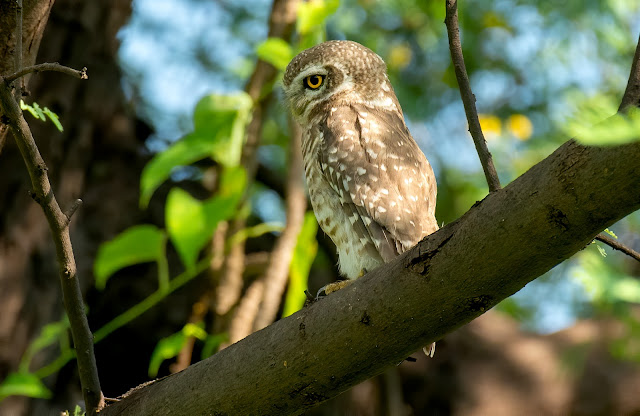 |
That spooky one-eye of the tiny cute bundle Spotted Owlet PC: Kalirajan Subramanian
|
Waders and Water birds
Keoladeo national park is famed for water birds owing to the large wetland ecosystem present there. During peak migration season one can see pelicans, spoon bills, cranes and numerous varieties of ducks. During this visit, we were still fortunate to see flocks of nesting openbills, darters and the migratory lesser whistling ducks.
 |
| Black headed ibis PC: Kalirajan Subramanian |
 |
Oriental Darter Male PC: Kalirajan Subramanian
|
 |
| A darter mother feeding her chicks in the nest. The chicks are white when young and develop colour as they mature. The nests are large and usually made on bare tree tops in wetlands. PC: Kalirajan Subramanian |
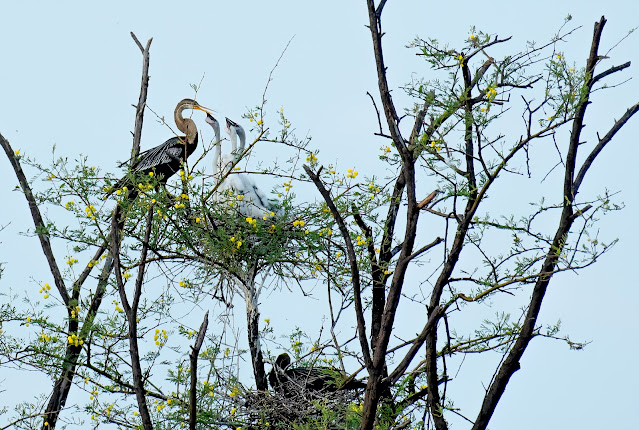 |
| Another darter mother feeding her nesting chicks PC: Kalirajan subramanian |
 |
| A picturesque silhouette of an oriental darter against the sunset PC: Kalirajan Subramanian |
 |
| Grey heron PC: Kalirajan Subramanian |
 |
| A breeding-plumage cattle egret checks out the newly grown flora PC: Kalirajan Subramanian |
 |
| Little egret and Grey heron PC: Kalirajan Subramanian |
 |
A flock of nesting Asian open bills on their nests PC: Kalirajan subramanian
|
 |
| Asian openbill stork with its chicks in the nest PC: Kalirajan Subramanian |
 |
| White breasted waterhen PC: Kalirajan Subramanian |
 |
| The slender vinely-neck of a Purple heron PC: Kalirajan Subramanian |
 |
| Purple heron taking-off PC: Kalirajan Subramanian |
 |
| Lesser whistling ducks shining in the evening sunlight. they get their name from the whistling sound they make in flight. So the next time you hear a whistle from the skies and notice birds flying at soaring heights, you know who. PC: Kalirajan Subramanian |
 |
| A lone Lesser whistling duck PC: Kalirajan Subramanian |
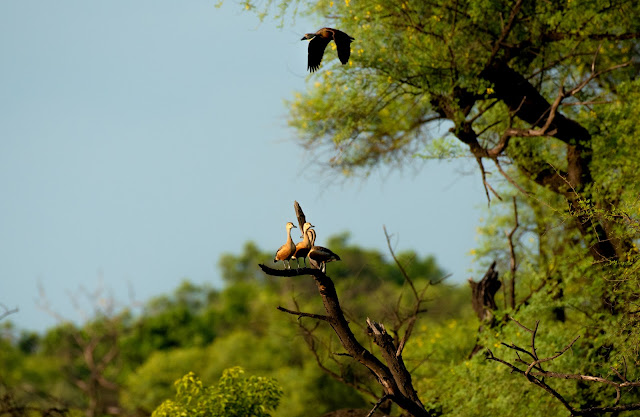 |
| Another group of lesser whistling ducks. They are local migrants who move within parts of Indian subcontinent based on seasons and water availability PC: Kalirajan Subramanian |
 |
| Team huddle of glowing Lesser whistling ducks PC: Kalirajan Subramanian |
Fauna
The park teams with a variety of fauna like the Nilgai, sambar and spotted deers along with other animals like wild boar, mongoose, smaller cats and macaques. The Nilgai which were once considered vermin and widely hunted are also making a comeback after conservatory efforts.
 |
| The golden red rear of recess macaque that sets it apart from bonnet macaques PC: Kalirajan Subramanian |
 |
| Nilgai Male PC: Kalirajan Subramanian |
 |
Blue bull or Nilgai Male is the largest Asian antelope PC: Kalirajan Subramanian
|
 |
| Nilgai Female PC: Kalirajan Subramanian |

























































Comments